
South Jersey Economy Flourishes
The region’s unique attributes continue to attract economic activity in a multitude of industries.
By Jim Pytell, Assistant Editor On Sep 7, 2019New Jersey’s economy has remained steady over the past several years. While it’s easy to focus on the buzzing North Jersey hubs near the New York City mecca, South Jersey has – perhaps quietly – bolstered itself as a major contributor to the state’s overall economic picture.
“The region is well positioned to grow over the long-term,” says Marlene Asselta, president of the Southern New Jersey Development Council. “South Jersey has a highly educated workforce and its land availability is geographically situated to serve the northern and southern states with a good transportation network. The region enjoys a quality of life – through open spaces, recreational and cultural activities – that makes this part of the state unique.”
In terms of a specific industry that could help buoy the region’s economy into the future, Asselta points to energy, particularly wind, solar and battery storage, as one example.
In June, the New Jersey Board of Public Utilities selected Ocean Wind, an offshore wind energy project proposed by Ørsted with support from PSEG, to develop an 1,100 MW offshore wind farm, that, upon completion, will power more than half-a-million New Jersey homes.
Ocean Wind will be located 15 miles off the coast of Atlantic City, with construction expected to commence in the early 2020s. The wind farm is expected to be operational in 2024.
The project will bring significant investments to New Jersey, as Ørsted will launch its Pro-NJ Trust fund in Cape May and Atlantic counties, which will invest up to $15 million in grants to support local infrastructure investments and to support small, women and minority-owned business owners who wish to become part of the emerging offshore wind industry. Ørsted is also proceeding with plans to establish an operation and maintenance base in Atlantic City that will provide permanent, high-skilled jobs during the more than 25-year lifespan of the project.
“Ocean Wind will ensure that the state and its residents not only benefit from clean, renewable power, but that they reap the rewards of being an early player in the offshore wind industry as it grows in the US,” says Thomas Brostrøm, CEO of Ørsted US Offshore Wind and president of Ørsted North America.
Atlantic City at the Forefront
According to Stockton University’s South Jersey Economic Review, Atlantic City’s economy added 4,600 jobs in 2018, an increase of 3.6% over the previous year. 2018’s rate of job growth in the city was its best since the late 1980s, a period that saw robust job creation tied to that decade’s second wave of casino building. The review also states that employment in the metropolitan area’s casino hotels increased by 3,500 (+17.8%) in 2018. That increase was the gaming sector’s largest since 1990.
It’s now been more than a year since the openings of Hard Rock Hotel & Casino and Ocean Resort Casino, both of which have injected new life into South Jersey’s premier destination city. This summer also marked Caesars Atlantic City’s 40th anniversary, with the brand adding $170 million in capital investments and improvements into its Atlantic City resorts over the last several years, including most recently the debut of Gordon Ramsay Steak and a $56-million hotel renovation at the brand’s Harrah’s Resort property.
It’s also been more than a year since sports betting became legal in the state, and its impact has been substantial, with New Jersey taking in more than $2.9 billion in sports bets over the first 12 months of legalization.
In fact, New Jersey’s sportsbooks actually overtook Nevada’s for the first time ever in May after New Jersey books took $318.9 million in bets, beating Nevada books’ $317.4 million in wagers that month, according to each state’s respective regulators.
“We view sports betting as another amenity that attracts people to the city,” Jim Wood, president and CEO of Meet AC, says.
“The Atlantic City area is continuing to show growth and resilience,” adds Rummy Pandit, executive director, Lloyd D. Levenson Institute of Gaming, Hospitality & Tourism, Stockton University. “The city strengthens itself by increasingly becoming a gaming and non-gaming destination resort.”
Pandit and Wood agree that diversifying amenities in order to attract a younger audience like millennials is imperative to the long-term economic health of the city.
“One of the things we continue to do is evaluate how [Atlantic City] can continue to evolve as a destination,” Wood says. “The industry looks at adding different types of nightclubs and entertainment to attract a variety of crowds.”
From a mix of musical genres when it comes to concerts, to a variety of unique sporting events, to a host of restaurants that showcase New Jersey’s diverse cultural cuisine, Wood says that the key is variety and an ability to offer something to satiate everyone’s individual interests and desires.
“We are now booking conventions in Atlantic City seven years out,” Wood continues. “Going back to 2014, Atlantic City was only booking conventions 18 months out. It was a philosophy change. In the past, the gaming market was so strong, there wasn’t a big drive to go after the convention market, but now that there’s saturation in the gaming market, we’ve examined how to really grow that convention space.”
Camden’s Record Unemployment
In Camden, South Jersey’s largest city, the unemployment rate fell to 6.8% in May – the lowest it has been in 30 years. In 1990, Camden’s unemployment rate was 16.4%, reaching as high as 24% in 1992.
“Camden’s rise is objectively verified by the fact that more than $2.5 billion in investments have been made in the city’s parks, roads, public safety infrastructure, neighborhood schools, new commercial and housing developments, and ‘eds & meds’ institutions,” explains Kris Kolluri, president and CEO of Cooper’s Ferry Partnership.
The city is not without its challenges though, as it’s been mentioned in an ongoing controversy regarding state tax incentives for some businesses along the Camden Waterfront.
Asselta believes that a new, meaningful tax incentive program with better oversight may evolve in the future.
Industrial Real Estate
According to James Whitesell, executive vice president, leasing at Whitesell Construction Co., Inc., the South Jersey office market continues to lag behind its strong industrial market.
“We expected the industrial market to continue on its roll of positive space absorption, and were witness to a number of new leases, key renewals, and tenant expansions within our portfolio that has continued into this year,” he explains.
Looking ahead, Whitesell says that with the office market’s excess capacity, conversions of well-located properties into other uses are likely to follow.
“The industrial market seems well-poised to continue its run,” he says. “The future remains stable in the near term with some likely mixed effects during the next election cycle period. The industrial market’s strength and continued demand for warehouse space has been exceptional, and we could not have predicted the number of tenant expansions within our portfolio over the past two years.”
Higher Education Happenings
As one of the most highly educated states in the country, it’s no surprise that New Jersey’s universities play a major role in its overall economy. Rowan University alone has an economic impact of $1.53 billion, according to private research firm Econsult Solutions. Rowan directly supports 4,460 jobs at the university and close to 7,000 jobs indirectly in New Jersey each year, according to the firm.
In Glassboro, Rowan generates approximately $136 million in total output, supporting 1,200 jobs outside the institution and contributing to $62 million in earnings.
In addition to direct spending by the university, Rowan affiliates and partners have undertaken projects closely aligned with the university that will have huge, positive impacts, such as the $426-million, mixed-use Rowan Boulevard and the $350-million Inspira Medical Center Mullica Hill, which at press time is expected to open later this year.
A particularly significant merger between Cumberland County College and the Rowan College of Gloucester County officially took place as well, with the two institutions becoming the Rowan College of South Jersey. The merger is the first of its kind in the state, and Senate President Stephen Sweeney says it will go a long way in giving community colleges credentials and credibility many lacked in the past.
Additionally, in Camden’s “eds and meds” corridor, the 100,000-square-foot, $70-million Joint Health Sciences Center is expected to be completed this fall. This biomedical hub will connect Rowan University, Rutgers University–Camden, Camden County College, and the Cooper Medical School of Rowan University in a collaborative space dedicated to research.
Conclusion
It’s impossible to list every development and initiative going on in the state’s lower eight counties, which speaks to the tremendous progress of the region as a whole. Asselta also points out that South Jersey is well positioned to play a key role in New Jersey’s goal of fostering an innovation economy, which sets the state up well to be a major player in the industries of the future.
One example of this is the opening of the first building in the National Aviation Research and Technology Park (NARTP) in Egg Harbor Township, which is a key component of the developing aviation and aerospace innovation hub being developed in Atlantic County. NARTP will be comprised of seven buildings with 400,000 square feet of research and development space.
Additionally, Cape May County has devoted significant resources to its UAS (drone) Program over the past five years, on the premise that tech will provide higher-paying, year-round jobs advancing the county beyond its traditional tourism economy.
The county also is a unique test bed area for advanced UAS missions by those seeking good airspace and land facilities for research and development. It has its own COA, authorization from the FAA to fly UAS missions with a public purpose over the 400 foot ceiling that currently limits most commercial flights.
To welcome the influx of new UAS and other tech-related businesses, the county has broken ground on a major “Tech Village” project at the Cape May County Airport. Modelled architecturally after the World War II hangars that originally populated the airport, Tech Village is a $6.2-million, 20,000-square-foot project that will serve as an innovation hub. The US Economic Development Administration provided $3 million toward building.
Cape May County Freeholder Will Morey calls Tech Village “the start of a reimagining of Cape May County’s economic future.” Morey notes that the multiplier effect from new tech companies not only means new jobs, but will drive increased traffic at local businesses, restaurants, hotels, service industries and in the regional housing market.
Overall, it’s the region’s unique position to be a home base for cutting-edge research and development when it comes to wind energy that could prove extremely beneficial for the entire state in the near future.
“Becoming the hub for the development and expansion of wind energy up and down the eastern seaboard will encourage the development of a stronger workforce dedicated to wind energy research and development resulting in an intellectual benefit to South Jersey, as well as the state as a whole,” Asselta concludes.
To access more business news, visit NJB News Now.
Related Articles:





